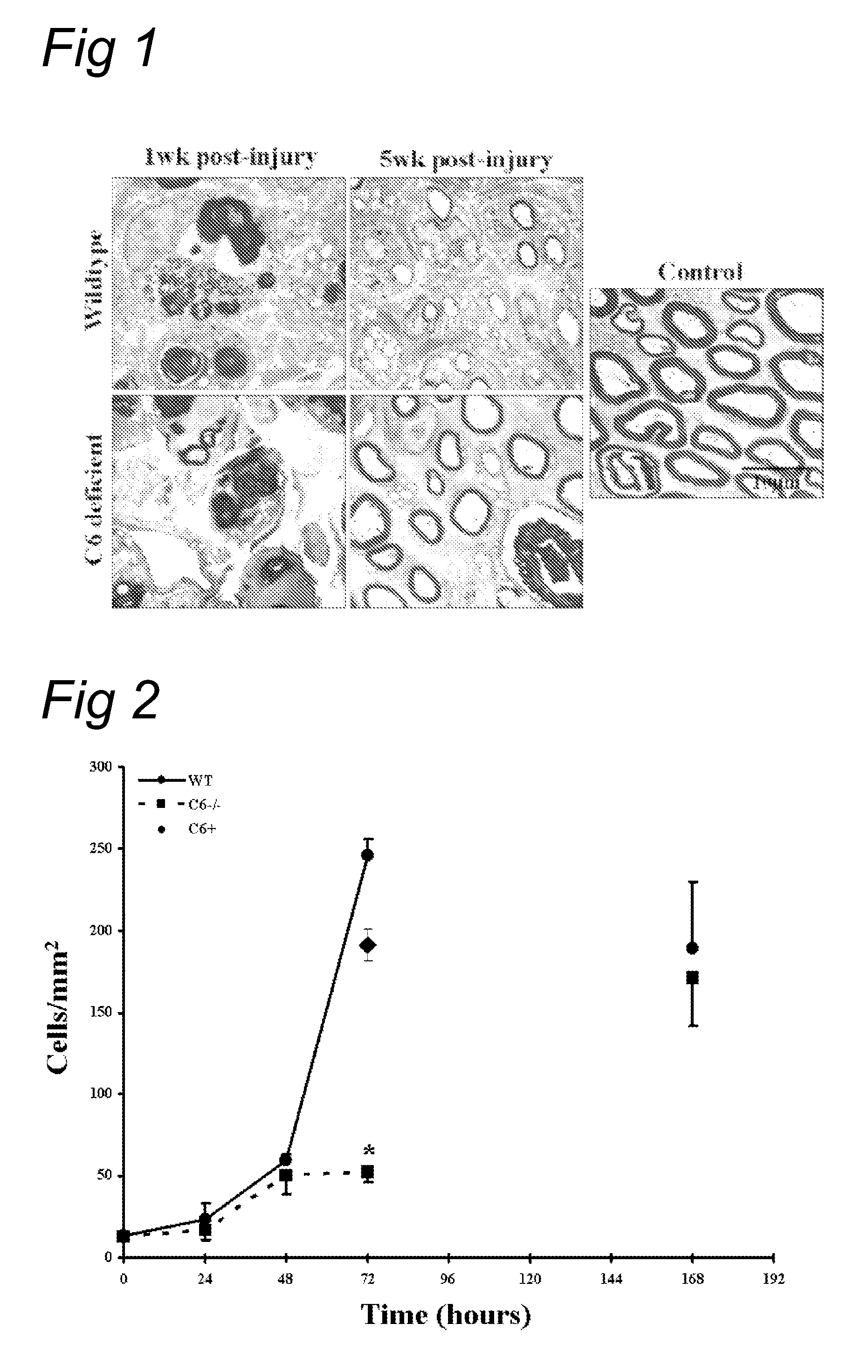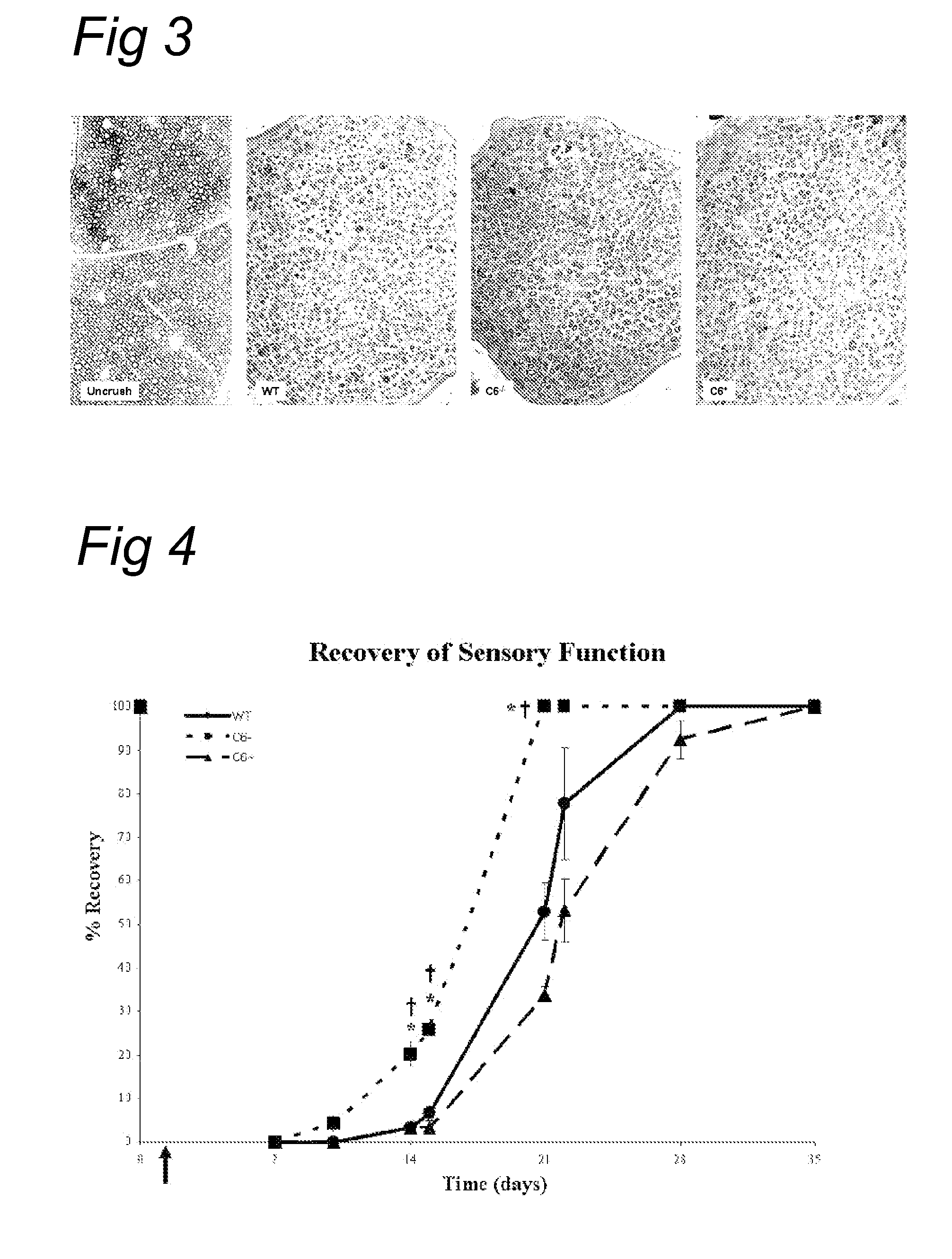Complement inhibition for improved nerve regeneration
a technology of complement inhibition and nerve regeneration, which is applied in the direction of antibody medical ingredients, peptide/protein ingredients, metabolism disorders, etc., can solve the problems of loss of neuronal function, degeneration of transected axons, and slow regeneration
- Summary
- Abstract
- Description
- Claims
- Application Information
AI Technical Summary
Benefits of technology
Problems solved by technology
Method used
Image
Examples
example 1
1. Example 1
Improved Post-Traumatic Nerve Recovery in Complement Component C6 Deficient Rats as Compared to Wild-Type Rats
1.1 Electron Microscopic Analysis
[0068]We have explored the role of the complement system in acute and chronic nerve injury and during regeneration. As a model we used the complement C6 deficient PVG rat strain (Bhole and Stahl, 2004) and compared this with wild type PVG rats. Since the complement system has many functions we chose an animal model in which only the most terminal effectors of the complement cascade was defective.
[0069]The effect of complement inhibition on nerve regeneration was studied in the acute model of nerve crush (Glass, 2004). The right sciatic nerve was crushed for 30 seconds in wild type as well as in the C6-deficient PVG rats. Tibial nerve was then analyzed 1 and 5 weeks after injury (see FIG. 1).
[0070]At one week, electron microscopy shows equally severe degeneration in wild type and in C6 deficient rats. At 5 weeks, the C6 deficient r...
example 2
Inhibition of Complement Activation after Nerve Crush by Human C1-Inhibitor
[0082]We tested whether recombinant human C1-inhibitor (rhC1INH; obtained from Pharming, Leiden, The Netherlands) is able to inhibit the rapid (1 hr) complement activation after nerve crush. FIG. 5 shows C1q, C4c and C3c immunostaining of injured wild type rat sciatic nerves treated with rhC1INH or vehicle (PBS) alone at 1 hour after nerve crush. High immunoreactivity for C1q is present in all crushed nerves, confirming C1q up-regulation after the crush injury. C4c and C3c immunoreactivity was detected in the PBS-treated nerves as expected but no C4c and C3c immunoreactivity was detected in the nerves from the rhC1INH treated rats sacrificed at 1 hr post-injury. This demonstrates effective blockade of the complement cascade by rhC1INH after crush and suggests that the alternative pathway of complement activation is not involved in the crush injury model of Wallerian degeneration. Thus, activation of the compl...
example 3
The Effect of Soluble CR1 on Post Traumatic Nerve Regeneration
[0083]Next, we tested the effect of soluble CR1 (sCR1) on post traumatic nerve regeneration. sCR1 inhibits the C3 / C5 convertase, and thereby affects both the classical and alternative pathway of the complement system.
[0084]Wild type PVG rats were treated with soluble CR1 (TP10 from Avant Immunotherapeutics, Inc.) at a dose of 15 mg / kg / day (TP10 soluble CR1 was obtained from Prof. P. Morgan, Cardiff, UK). Control rats were treated with the same volume (600 μl) of vehicle alone (PBS). Soluble CR1 or PBS was delivered i.p. 24 hours before the crush and every following day for a maximum of 8 injections (up to day 6 after crush). The sciatic nerve of the right leg was crushed and the left leg served as control. Both histology and sensory function were analysed.
[0085]FIG. 6 shows that in a functional analysis with the footflick test a faster recovery of the sensory function is seen in the sCR1-treated animals compared to the PB...
PUM
| Property | Measurement | Unit |
|---|---|---|
| currents | aaaaa | aaaaa |
| time | aaaaa | aaaaa |
| half life | aaaaa | aaaaa |
Abstract
Description
Claims
Application Information
 Login to View More
Login to View More - R&D
- Intellectual Property
- Life Sciences
- Materials
- Tech Scout
- Unparalleled Data Quality
- Higher Quality Content
- 60% Fewer Hallucinations
Browse by: Latest US Patents, China's latest patents, Technical Efficacy Thesaurus, Application Domain, Technology Topic, Popular Technical Reports.
© 2025 PatSnap. All rights reserved.Legal|Privacy policy|Modern Slavery Act Transparency Statement|Sitemap|About US| Contact US: help@patsnap.com



